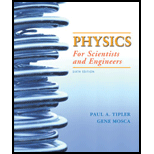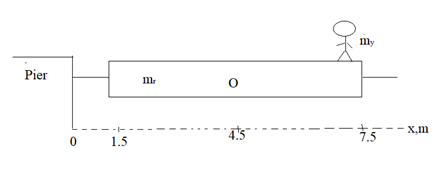
Concept explainers
(a)
The center of mass of the you-raft system from the end of the pier when you are at the very rear.
(a)
Answer to Problem 138P
The center of mass of the you-raft system from the end of the pier when you are at the very rear is at
Explanation of Solution
Given:
Length and mass of the raft are
Your mass is
Formula used:
The edge of the pier is taken as the origin and the right side of the pier is taken as positive

Figure:
In the figure

Figure:
The center of mass of the you-raft system (
Where,
Calculation:
By substituting numerical values in equation
Conclusion:
The center of mass of the you-raft system from the end of the pier when you are at the very rear is at
(b)
The center of mass of the you-raft system from the end of the pier when you are at front
(b)
Answer to Problem 138P
The center of mass of the you-raft system from the end of the pier when you are at front is at
Explanation of Solution
Formula used:
Where,
Calculation:
The distance of the raft from the pier after you have walked to the front of the raft is,
Because
Since,
Substituting
By substituting the numerical values in the above equation,
Substituting this value in equation (4),
Conclusion:
The center of mass of the you-raft system from the end of the pier when you are at front is at
(c)
The distance between you and the end of the pier when you are at the front of the raft.
(c)
Answer to Problem 138P
The distance between you and the end of the pier when you are at the front of the raft is at
Explanation of Solution
Formula used:
Where,
Calculation:
Substituting numerical values in equation in equation
Conclusion:
The distance between you and the end of the pier when you are at the front of the raft is at
Want to see more full solutions like this?
Chapter 5 Solutions
Physics For Scientists And Engineers
- Find the center of mass of a rod of length L whose mass density changes from one end to the other quadratically. That is, if the rod is laid out along the x-axis with one end at the origin and the other end at x=L , the density is given by (x)=0+(10)(xL)2 , where 0 and 1 are constant values.arrow_forwardWhere is the center of mass of a semicircular wire of radius R that is centered on the origin, begins and ends on the x axis, and lies in the x, y plane?arrow_forwardThree skydivers are plummeting earthward. They are initially holding onto each other, but then push apart. Two skydivers of mass 70 and 80 kg gain horizontal velocities of 1.2 m/s north and 1.4 m/s southeast, respectively. What is the horizontal velocity of the third skydiver, whose mass is 55 kg?arrow_forward
- The magnitude of the net force exerted in the x direction on a 4.00-kg particle varies in time as shown in the figure below.arrow_forwardFind the center of mass of the regular ∟-shaped iron bar with sides 0.40 m and 0.70 m, respectively. (Assume the ∟ shape of the rod is thin.)arrow_forwardFind the center of mass of a uniform thin semicircular plate of radius R. Let the origin be at the center of the semicircle, the plate arc from the +x axis to the -x axis, and the z axis be perpendicular to the plate.arrow_forward
- If 1 of the Earth’s mass were transferred to the Moon, how far would the center of mass of the Earth-Moon-population system move? The mass of the Earth is 5.971024kg and that of the Moon is 7.341022kg . The radius of the Moon’s orbit is about 3.84105m .arrow_forwardWhere is the center of mass of a slice of pizza that was cut into eight equal slices? Assume the origin is at the apex of the slice and measure angles with respect to an edge of the slice. The radius of the pizza is R.arrow_forwardCheck Your Understanding How does your weight at the top of a tall building compare with that on the first floor? Do you think engineers need to take into account the change in the value of g when designing structural support for a very tall building?arrow_forward
- Find the center of mass of a thin plate covering the regionbetween the x-axis and the curve y = 2>x2, 1 … x … 2, if theplate’s density at the point (x, y) is d(x) = x2.arrow_forwardA set of fossilized triceratops footprints discovered inTexas show that the front and rear feet were 3.2 m apart. The rearfootprints were observed to be twice as deep as the front footprints.Assuming that the rear feet pressed down on the ground with twicethe force exerted by the front feet, find the horizontal distance fromthe rear feet to the triceratops’s center of mass.arrow_forwardAt the scene of an accident, two traffic experts appear to determine which of the drivers was at fault considering that it was a highway where the speed limit is 80 km / h. The data collected in the field indicate that the vehicles stuck and skidded together a length of 25 m on the pavement whose dynamic friction coefficient is μk = 0.30. Considering that the masses of vehicles A and B are 2300 kg and 1500 kg, respectively, specify which of the cars was speeding at the moment of impact and by how much it exceeded the speed limit. Express your result in km / h for the purposes of the expertise.arrow_forward
 University Physics Volume 1PhysicsISBN:9781938168277Author:William Moebs, Samuel J. Ling, Jeff SannyPublisher:OpenStax - Rice University
University Physics Volume 1PhysicsISBN:9781938168277Author:William Moebs, Samuel J. Ling, Jeff SannyPublisher:OpenStax - Rice University
